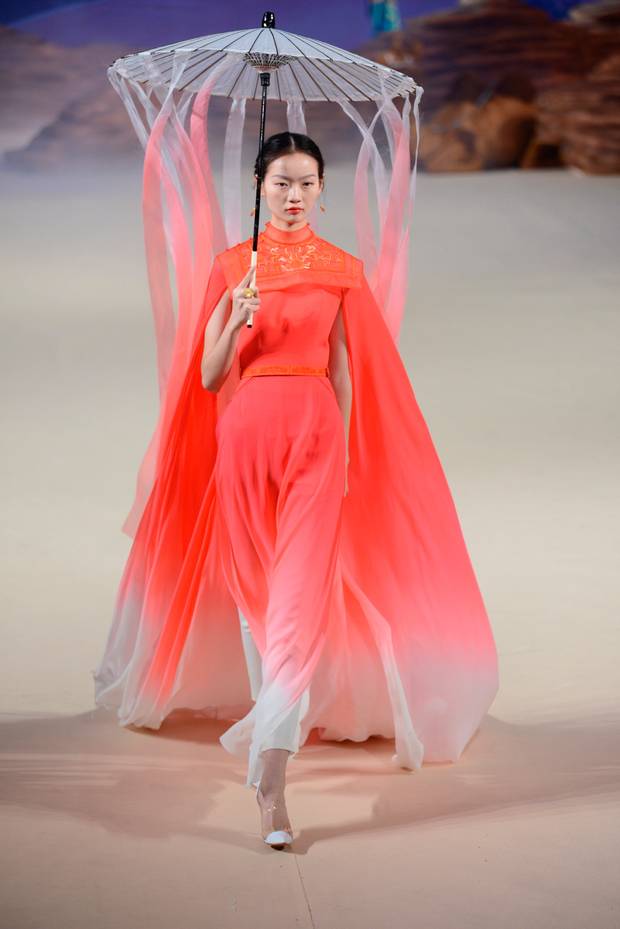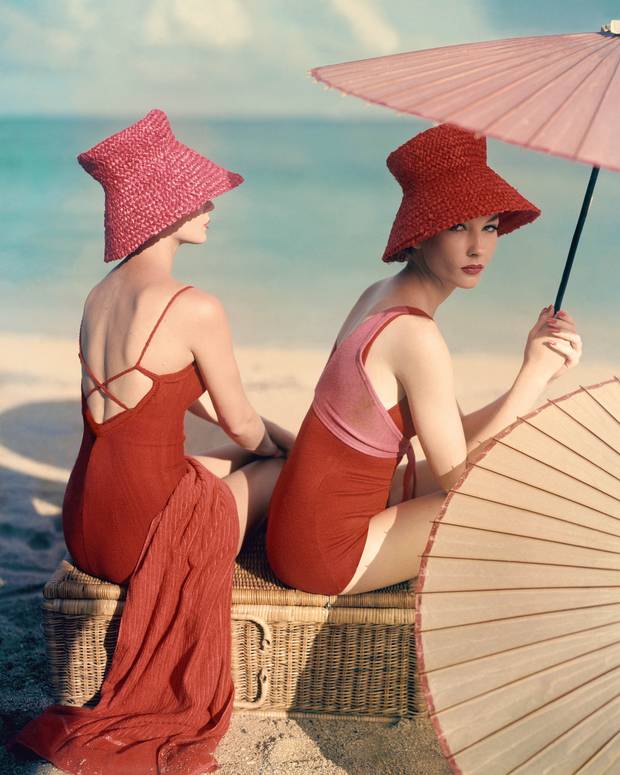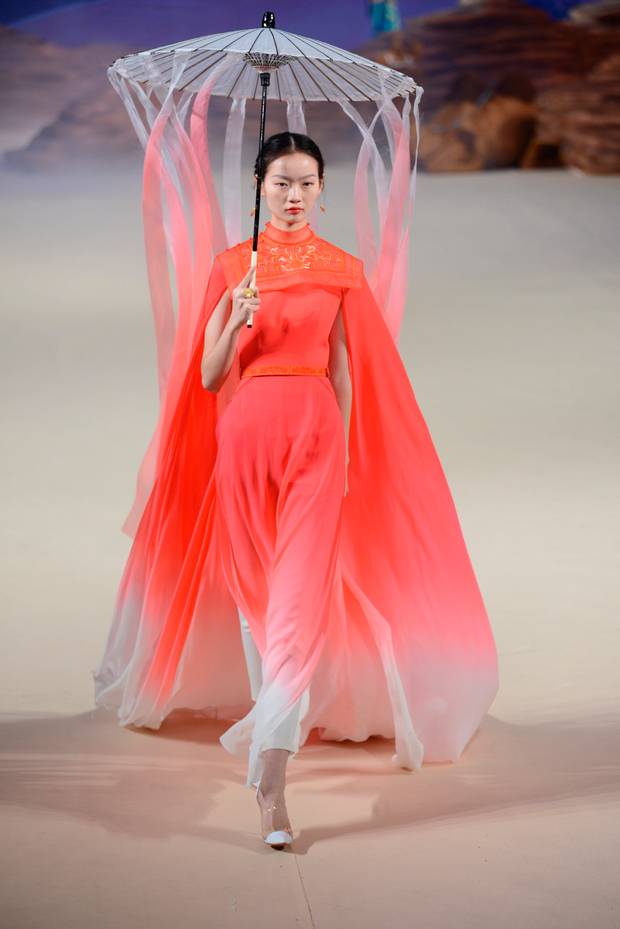 Coral ombre-style by designer Xiong Ying at China Fashion Week SS19 in Beijing Two models seated on a wicker basket at the beach, published in Vogue in 1959 Highly collectible vintage is a key pillar of the slow fashion movement. This illustration by the legendary Hollywood costume designer Edith Head was her design for Audrey Hepburn in Billy Wilder’s Sabrina (1954) Joanna Kaminska’s ‘Daily Mantras’ hand-rolled deep-orange silk crêpe de chine scarf, available in two sizes, €180 and €240, from jokamin.com; Atrium, Powerscourt Townhouse Centre, Dublin 2, and Sevenoaks and Steele Design Workshop, Bray. Print painted in Cork and printed on silk in Italy Sustainability is central to artist/designer Helen Steele, whose ‘Cora’ bubble dress features her new SS19 ‘Daije’ print, in silk with silk-satin ruffles, €725, from Costume, Castle Market, Dublin 2, available from the second week of January
Coral ombre-style by designer Xiong Ying at China Fashion Week SS19 in Beijing Two models seated on a wicker basket at the beach, published in Vogue in 1959 Highly collectible vintage is a key pillar of the slow fashion movement. This illustration by the legendary Hollywood costume designer Edith Head was her design for Audrey Hepburn in Billy Wilder’s Sabrina (1954) Joanna Kaminska’s ‘Daily Mantras’ hand-rolled deep-orange silk crêpe de chine scarf, available in two sizes, €180 and €240, from jokamin.com; Atrium, Powerscourt Townhouse Centre, Dublin 2, and Sevenoaks and Steele Design Workshop, Bray. Print painted in Cork and printed on silk in Italy Sustainability is central to artist/designer Helen Steele, whose ‘Cora’ bubble dress features her new SS19 ‘Daije’ print, in silk with silk-satin ruffles, €725, from Costume, Castle Market, Dublin 2, available from the second week of JanuaryNew Year, new you, and there’s a fresh new Pantone Colour of the Year for us to contemplate. Ever worn a shade of deep orange before? No, neither have I, but chances are we will in 2019, as ‘Living Coral’ has been chosen as the new Pantone colour du jour. This orangey/peachy/coral hue will be popping up in fashion, interiors and home furnishings everywhere. Why the fuss, you ask?
Over the past 20 years, the Pantone Colour of the Year has influenced product development and purchasing decisions in multiple industries – from fashion to industrial design as well as product-packaging and graphic design.
Praised for its “optimism”, the new colour is, according to experts, a “life-affirming coral hue with a golden undertone that energises and enlivens with a softer edge”.
Big sell, indeed, but it certainly works well if you are chasing megawatt impact. Bravehearts will favour a statement head-to-toe approach, but I think we can learn a lesson or two from style icons of the past who explored such hues by working them with tone-on-tone ‘sister’ colours, like brick, peach and terracotta – which comes with its own innate sophistication – all of which featured in this striking fashion image (right), published in Vogue in 1959.


For me, the stunning photograph captures the style essence of a time when quality construction and fabrication plus attention to detail reigned supreme. But what is most compelling for me about the image is reflecting on how much our consumption of fashion has changed between then and now.
Starting into a new year, and the close of the second decade of the 21st century, I think we owe it to ourselves and future generations to pause a moment and reflect on our consumption habits – and the consequences of those for our environment.
Those ladies back in the 1950s had two fashion seasons a year. While nowadays we still have Spring/Summer and Autumn/Winter, just as they did, we also have Pre-Season, High Summer and Cruise.
We buy way more clothes than our grandmothers and their mothers did, and, just as the arrival of cheaper, ready-to-wear collections triggered the demise of the designer couturier houses in the 1950s and ’60s, nowadays fast fashion has invaded our hearts and our wardrobes – but at what cost?
Retail is tough. The landscape is extremely competitive and the battle for value has never been harder fought, but one thing is for certain: the buy-and-chuck strategy of today would never have crossed the minds of our fashionable forebearers, who kept a vigilant eye on quality, not quantity. Just look at their closets. They usually had one, even shared one – none of the wall-to-wall storage modern-day consumers require now for their “stuff”.
Fast fashion imitates styles and trends seen on the runways and recreates them at a low price to sell to the mass market. True, it has brought a certain democratisation to the rag trade, but quality matters – and what happens to all those affordable interpretations of designers looks?
The infamous three-wears-before-it-shrinks T-shirt may be affordable for the consumer but it brings a much bigger cost for society – way beyond the original price tag of €5-€10. The desire for fast fashion has escalated the supply chain, and experts calculate that 25pc of fashion nowadays ends up in landfill.
On the cusp of an exciting new fashion season, we welcome newness, and we need to support an important industry which employs so many people across production, wholesale and retail. The latter has found itself in a state of flux as shoppers move across platforms, from traditional bricks and mortar to e-commerce, and into the mix go the added pressures of flash sales, promotions and advanced analytics.
However, before we start introducing new elements into our closets for 2019, shouldn’t we really take a hard look at what we already have, and adopt a responsible approach as we thin out hanger space to make room for incoming pieces? It’s never too late, and 2019 is an ideal time to really address the issue of sustainability. The best advice is to buy less and buy well. When it comes to emptying out the contents of our own closets, don’t dump – gift. Share with friends, sell on or, better again, send to charity shops that can take advantage of your largesse. Save the good pieces which will be the vintage of the future and don’t regard vintage and charity stores as “niche”. They are not: they have a very relevant place in the sustainable fashion conversation.
Recently, vintage queen Breda Casey, from the legendary Miss Daisy Blue vintage specialist shop in Cork’s Market Parade, was invited by Brown Thomas to be part of their Marvel Room experience. This was in recognition of the fact that vintage jeans and accessories, like old-school vintage scarves, have a place in the modern-day marketplace as shoppers increasingly buy between decades.
The slow fashion movement has long made a case for buying fewer garments at higher quality and seeking out goods made from more sustainable processes – where there is an emphasis on the art of clothes and the skills of the people who made them.
Sustainability and transparency sat at the forefront of every decision Katie O’Riordan made when she launched her new Irish brand, Theo & George (theoandgeorge.com), in September 2017. She focused on making ethical and smart decisions about both the companies she partnered with and the products she sold. “Sustainability has its complexities, as it’s not only about the materials we source, but also about the human side of the business. We don’t work with sweatshops – most of our factories only employ 10-15 people. We use natural fibres like cotton, cashmere, modal and bamboo, and we partner with factories that are transparent so we can trace our products back to the raw materials. Plus, we don’t overproduce – so we aren’t disposing of clothes that we can’t sell,” says Katie. The concept has paid off and it’s clear to Katie from a survey Theo & George carried out with customers this month that this commitment to quality and sustainability is important. “The key trends we are seeing for 2019 are sustainability, high-quality garments, colour and a desire for luxurious essentials that can be worn as part of a capsule wardrobe.”
Artist-designer Helen Steele (whose new SS19 dress is pictured on page 23) works in natural fabrics and keeps the carbon footprint of her range to an absolute minimum. The Daije print was hand-painted at her studio in Emyvale, Co Monaghan, last summer, based on a chromosome idea. The silk was printed in the Netherlands and all her dresses are handmade in Dublin. She recently collaborated with the artist Maser and, in February, they are launching a limited-edition collection of Hawaiian shirts and dresses.
Jean McCabe – who won the coveted National Store of the Year prize in the recent Retail Excellent Awards – is all about colour in her two Willow stores, in Ennis and Galway. It’s hard not to think beyond dark winter days when you see the vibrant colours in her Exquise buy.
Weekend Magazine


